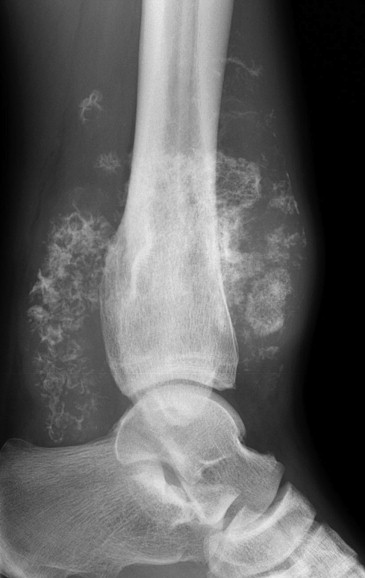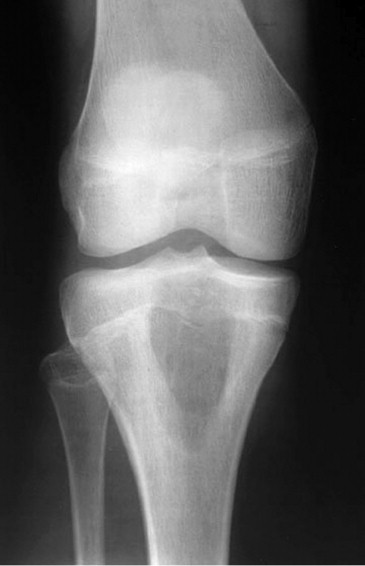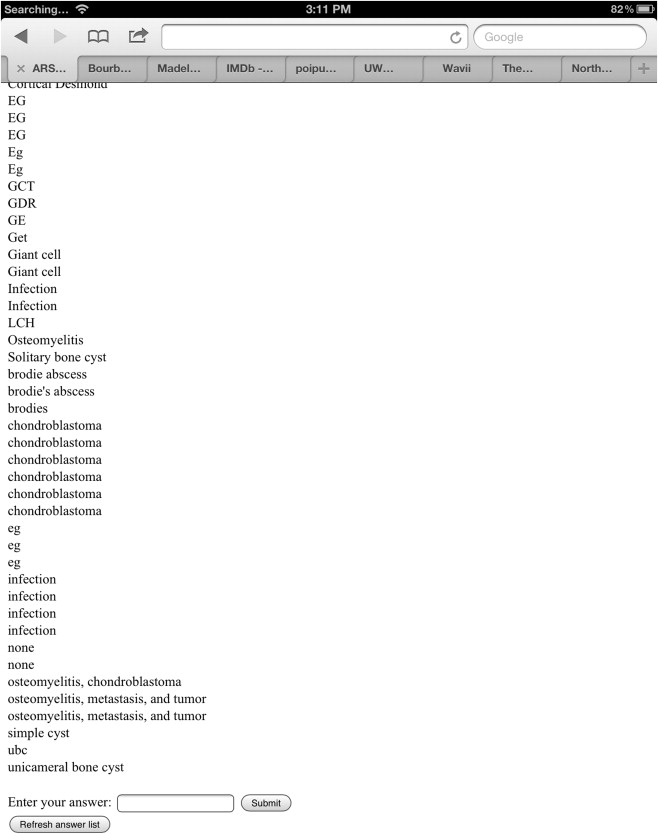Introduction
Audience response system (ARS) provides an excellent tool for improving interactive learning in radiology residents. However, it is not the technology but the pedagogy that matters the most. It is long past time to upgrade our ARS teaching techniques to match our ARS technology.
Discussion
In this article, several problems with current usage of ARS are discussed and several prescriptions for improving this are presented. Simplifying the ease of use of ARS will get this useful technology into more hands. Using ARS in a bidirectional manner will give us an even better idea of how and what our students are learning. Asking questions on the fly will obviate the usual tedium of multiple-choice questions and allow us to quiz our students in a much more natural manner. It is time to move on to more innovative ARS techniques that are well adapted to radiology and its different styles of learning.
Audience response systems (ARS) have been available since the 1960s . Because prices have dropped and availability has risen, these systems have become increasingly popular as pedagogic tools. ARS technology enables active learning by allowing real-time polling of student opinions and knowledge and by improving attentiveness and engagement in the classroom.
Unfortunately, the promise of ARS has been held back because of the outdated way most people use it. I cannot see a lot of difference between the computer-graded paper Scholastic Aptitude Test (SAT) that I took in the 1960s and the way most lecturers use ARS today. I see the same type of questions that have been used since 1926, when the multiple-choice SAT was introduced as a faster way of testing college applicants. . We are using a computer and a set of clickers, but it is qualitatively the same test .
The result from blindly shoveling in content from an older to a newer medium—without regard for new features or possibilities—has been termed “shovelware” . Many of the first movies were shovelware, because they were created by simply filming a stage play, one of the main entertainment venues of that era. It took >100 years to develop today’s language of cinematography, with techniques such as close-ups, action scenes, location shots, shifting points of view, special effects, and other techniques. We went through this same scenario in the 1990s with the birth of the Web. Most early Web pages were virtual pieces of paper shoved onto the Web. Since then, Web technology has advanced considerably, with the addition of sound and video files, dynamic Hypertext Markup Language, database-backed Websites, Webcams, cascading stylesheets, and other innovations.
In contrast, ARS techniques have remained relatively static over the past 50 years—the technology has evolved, but the way it is used has not. The purpose of this article is to suggest some promising paths forward.
Benefits of an ARS
Get Radiology Tree app to read full this article<
Get Radiology Tree app to read full this article<
Get Radiology Tree app to read full this article<
Table 1
Comparison of Selected Audience Response Systems
System Uniform Resource Locator Allows Short-Answer Questions Representative Pricing ARSenic http://uwmsk.org/arsenic Yes Free Poll Everywhere http://polleverywhere.com Yes Free for 40 students H-ITT http://h-itt.com Yes on some models $316 rental fee + $3 per clicker per day Fleetwood http://www.replysystems.com/ Yes, but awkward $35 per clicker + $400 per receiver TurningPoint http://www.turningtechnologies.com/ Yes with app ∼ $12 per user per year eInstruction http://www.einstruction.com/ No ∼50 per clicker + $160 per receiver iClicker http://iclicker.com/ No $27 per clicker + $110 per base IML http://www.imlaudienceresponse.com/ Yes $20 per clicker per day Meridia http://www.meridiaars.com/ Yes with some models $13 per clicker per day Qwizdom http://www.qwizdom.com/ Single word $40 per clicker eClicker http://www.bignerdranch.com/apps/ No $10 per smartphone
Get Radiology Tree app to read full this article<
Get Radiology Tree app to read full this article<
Get Radiology Tree app to read full this article<
Problems with 20th Century ARS Techniques
Get Radiology Tree app to read full this article<
Get Radiology Tree app to read full this article<
Get Radiology Tree app to read full this article<
Get Radiology Tree app to read full this article<
Get Radiology Tree app to read full this article<
Twenty-first Century ARS techniques
Simplify the ARS Process
Get Radiology Tree app to read full this article<
Get Radiology Tree app to read full this article<
Get Radiology Tree app to read full this article<
Get Radiology Tree app to read full this article<
Get Radiology Tree app to read full this article<
Start Using Bidirectional ARS
Get Radiology Tree app to read full this article<
Get Radiology Tree app to read full this article<
Ask Your Questions on the Fly
Get Radiology Tree app to read full this article<
Get Radiology Tree app to read full this article<
Get Radiology Tree app to read full this article<
Get Radiology Tree app to read full this article<
Make Use of Innovative ARS Techniques
Get Radiology Tree app to read full this article<
Traditional case conference
Get Radiology Tree app to read full this article<
“Inverted” case presentation
Get Radiology Tree app to read full this article<
Progressive refinement case presentation
Get Radiology Tree app to read full this article<
Get Radiology Tree app to read full this article<
Table 2
Resident Response versus Level of Training
Resident Level Answer First year “Bad” or “mass” Second year Mass with “chondroid matrix” Third year Chondrosarcoma Fourth year Chondrosarcoma 2° to multiple hereditary exostosis syndrome
Get Radiology Tree app to read full this article<
Optimal protocol questions
Get Radiology Tree app to read full this article<
Optimal imaging workup
Get Radiology Tree app to read full this article<
Differential diagnosis
Get Radiology Tree app to read full this article<
Get Radiology Tree app to read full this article<
Get Radiology Tree app to read full this article<
Get Radiology Tree app to read full this article<
Peer instruction
Get Radiology Tree app to read full this article<
Real-time evaluation of teaching sessions by students
Get Radiology Tree app to read full this article<
Guidance from learning theory
Get Radiology Tree app to read full this article<
Table 3
Audience Response System (ARS) Techniques for Different Learning Models
ARS Technique Learning Model Traditional case conference Behaviorism “Inverted” case conference Behaviorism Optimal protocol questions Cognitivism Optimal imaging workup Cognitivism Bidirectional ARS Constructivism Progressive refinement case conference Constructivism Differential diagnosis Constructivism Peer instruction Constructivism
Get Radiology Tree app to read full this article<
Behaviorism
Get Radiology Tree app to read full this article<
Cognitivism
Get Radiology Tree app to read full this article<
Constructivism
Get Radiology Tree app to read full this article<
Conclusions
Get Radiology Tree app to read full this article<
Get Radiology Tree app to read full this article<
References
1. Wikipedia contributors. Audience response. Wikipedia, The Free Encyclopedia. December 13, 2013, 14:15 UTC. Available at: http://en.wikipedia.org/w/index.php?title=Audience_response&oldid=585906972 . Accessed January 21, 2014.
2. Mathews J: “Just whose idea was all this testing?; Fueled by technology, nation’s attempt to create a level playing field has had a rocky history”, The Washington Post, 2006.
3. Ravitch D.: The fall of the standard-bearers. Chron High Educ 2006; 52: pp. B44.
4. Mazur E.: Education. Farewell, lecture?. Science 2009; 323: pp. 50-51.
5. Wikipedia contributors. Shovelware. Wikipedia, The Free Encyclopedia. December 12, 2013, 06:08 UTC. Available at: http://en.wikipedia.org/w/index.php?title=Shovelware&oldid=585705656 . Accessed January 21, 2014.
6. Miller R.G., Ashar B.H., Getz K.J.: Evaluation of an audience response system for the continuing education of health professionals. J Contin Educ Health Prof 2003; 23: pp. 109-115.
7. Crouch C.H., Mazur E.: Peer instruction: ten years of experience and results. Am J Phys 2001; 69: pp. 970.
8. ARS vendor comparison. Available at http://www.polleverywhere.com/ars-comparison . Accessed August 31, 2013.
9. Response technology for mobile devices. Available at: http://www.turningtechnologies.com/ . Accessed August 11, 2013.
10. Eclicker presenter for iOS. Available at: http://www.eclicker.com/ . Accessed August 11, 2013.
11. Poll everywhere. Available at: http://www.polleverywhere.com . Accessed August 31, 2013.
12. Wikipedia contributors. Procrustes. Wikipedia, The Free Encyclopedia. November 10, 2013, 01:46 UTC. Available at: http://en.wikipedia.org/w/index.php?title=Procrustes&oldid=580981440 . Accessed January 21, 2014.
13. Item writing manual, National Board of Medical Examiners. Available at: http://www.nbme.org/publications/item-writing-manual-download.html . Accessed August 11, 2013.
14. Nicholson B.T., Bassignani M.J.: Radiologist/Educator knowledge of the audience response system and limitations to its use. Acad Radiol 2009; 16: pp. 1555-1560.
15. Schuwirth L.W., Vleuten C.P., Donkers H.H.: A closer look at cueing effects in multiple-choice questions. Med Educ 1996; 30: pp. 44-49.
16. Schuwirth L.W., van der Vleuten C.P.: Different written assessment methods: what can be said about their strengths and weaknesses?. Med Educ 2004; 38: pp. 974-979.
17. Epstein R.M.: Assessment in medical education. N Engl J Med 2007; 356: pp. 387-396.
18. Richardson ML. ARSenic, a free, open-source, web-based audience response system. Available at: http://uwmsk.org/arsenic/ . Accessed August 11, 2013.
19. Richardson M.L., Petscavage J.M., Hunter J.C., et. al.: Running an online radiology teaching conference. Acad Radiol 2012; 19: pp. 746-751.
20. Twitter. Available at: http://www.twitter.com . Accessed August 11, 2013.
21. Wikipedia contributors. Socratic method. Wikipedia, The Free Encyclopedia. January 10, 2014, 21:57 UTC. Available at: http://en.wikipedia.org/w/index.php?title=Socratic_method&oldid=590135846 . Accessed January 21, 2014.
22. American College of Radiology Expert Panels. ACR appropriateness criteria. Available at: http://www.acr.org/Quality-Safety/Appropriateness-Criteria . Accessed August 11, 2013.
23. Mazur E.: Peer instruction: a user’s manual.1997.Prentice HallUpper Saddle River, NJ
24. Smith M.K., Wood W.B., Adams W.K., et. al.: Why peer discussion improves student performance on in-class concept questions. Science 2009; 323: pp. 122-124.
25. Lasry N., Mazur E., Watkins J.: Peer instruction: from Harvard to the two-year college. Am J Phys 2008; 76: pp. 1066-1069.
26. Fagen A.P., Crouch C.H., Mazur E.: Peer instruction: results from a range of classrooms. The Physics Teacher 2002; 40: pp. 206.
27. Lewis P. Teaching portfolio. Alliance of clinician-educators in radiology, promotion resources: teaching portfolio template. http://www.aur.org/Secondary-Alliances.aspx?id=514 . Accessed August 11, 2013.
28. Thapa M. Personal communication, 2011.
29. Williamson K.B., Gunderman R.B., Cohen M.D., et. al.: Learning theory in radiology education. Radiology 2004; 233: pp. 15-18.
30. Wikipedia contributors. Operant conditioning chamber. Wikipedia, The Free Encyclopedia. January 7, 2014, 15:20 UTC. Available at: http://en.wikipedia.org/w/index.php?title=Operant_conditioning_chamber&oldid=589610747 . Accessed January 21, 2014.
31. Wikipedia contributors. Cognitivism (philosophy of education). Wikipedia, The Free Encyclopedia. January 18, 2014, 01:35 UTC. Available at: http://en.wikipedia.org/w/index.php?title=Cognitivism_(learning_theory)&oldid=591208230 . Accessed January 21, 2014.
32. Wikipedia contributors. Constructivism (philosophy of education). Wikipedia, The Free Encyclopedia. January 18, 2014, 13:17 UTC. Available at: http://en.wikipedia.org/w/index.php?title=Constructivism_(philosophy_of_education)&oldid=591267068 . Accessed January 21, 2014.
33. Guthrie J.T., Wigfield A., Barbosa P., et. al.: Increasing reading comprehension and engagement through concept-oriented reading instruction. J Educ Psychol 2004; 96: pp. 403-423.
34. Hmelo-Silver C.E., Duncan R.G., Chinn C.A.: Scaffolding and achievement in problem-based and inquiry learning: a response to Kirschner, Sweller, and Clark (2006). Educational Psychologist. Taylor & Francis 2007; 42: pp. 99-107.
35. Doğru M., Kalender S.: Applying the subject “cell” through constructivist approach during science lessons and the teacher’s view. International Journal of Environmental and Science Education 2007; 2: pp. 3-13.



